Home Decor
Painting Thrifted Treasures: 10 Steps From Drab to Fab
Marvel at the stunning makeover of thrifted treasures with 10 expert steps that will take them from drab to fab – discover the transformative magic within!
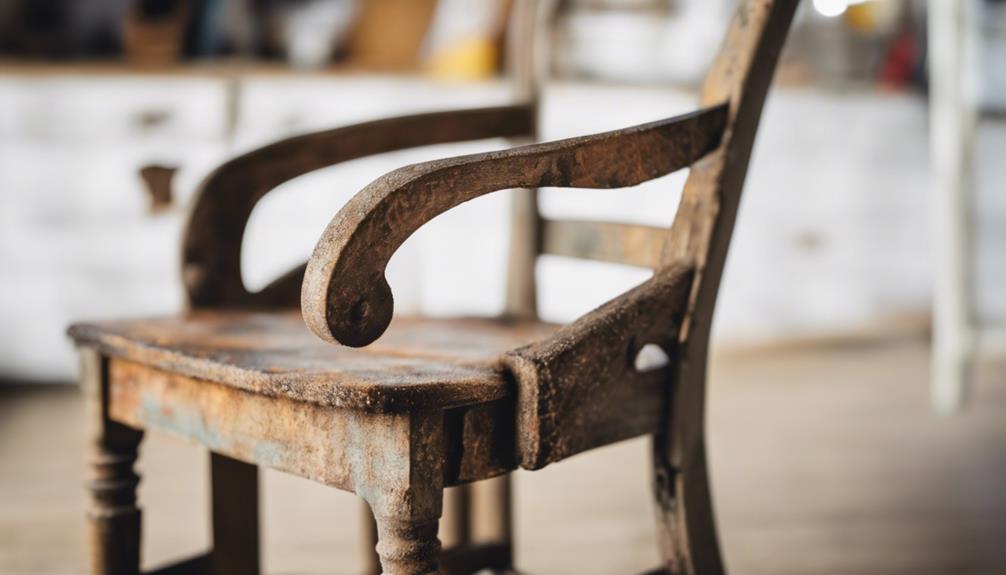
We're here to revamp thrifted treasures from drab to fab in 10 simple steps. Start by selecting sturdy wood pieces with unique features and evaluating for damage. Clean with mild soap, sand lightly, and fill imperfections for a smooth canvas. Sand with the grain, choose the right primer, and test paint colors before applying. Opt for specialized techniques like dry brushing for added texture. Wait for the paint to dry, seal it for protection, and add final touches like stencils for a polished look. Get ready to witness the magic of transformation! Additional secrets await.
Key Takeaways
- Choose solid wood pieces with interesting shapes.
- Clean, sand, and fix imperfections for smooth finish.
- Prime with appropriate type for strong bond.
- Apply paint with chosen method, add texture.
- Seal with durable finish, embellish for final touch.
Selecting Thrifted Treasures to Paint
When scouting out thrift stores, we're on the hunt for solid wood furniture pieces that have the potential to shine with a fresh coat of paint. We look for items with interesting shapes or details that can be enhanced with a new color. Before making a purchase, we make sure to inspect the item carefully, taking note of any damage or repairs needed. We put one piece aside if it has holes in the center or other major flaws that can't be easily fixed.
We also consider the size and scale of the item to make certain it fits well in our space after painting. We're not afraid to think outside the box and envision how a fresh coat of paint can transform an outdated piece into a unique treasure. We're on the lookout for items that have the potential for a dramatic transformation, like outdated colors or finishes.
Cleaning and Prepping Surfaces
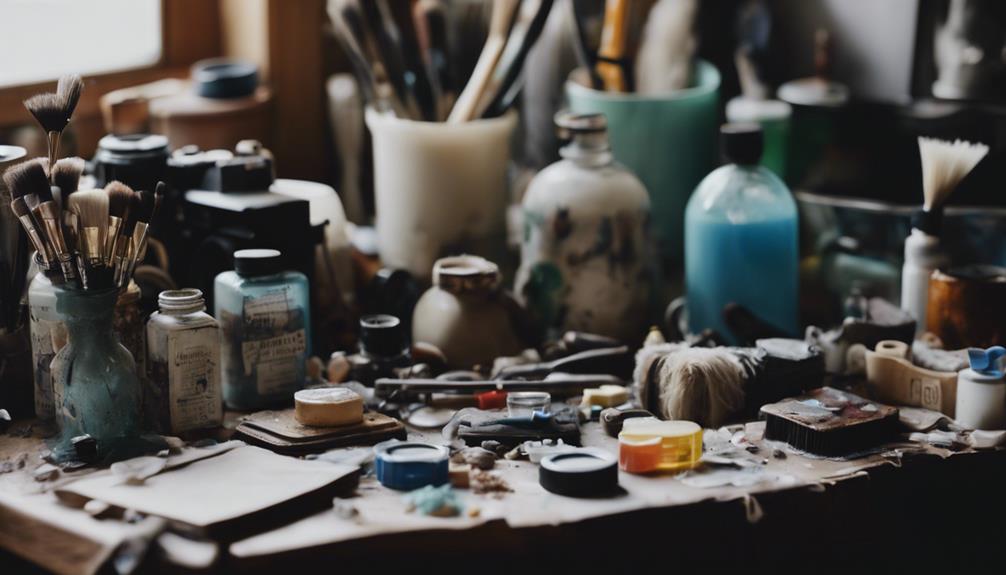
We take the time to meticulously clean and prep our thrifted treasures before applying a fresh coat of paint, recognizing that a solid foundation is essential to achieving a flawless finish. Cleaning surfaces is important to remove dirt, grime, and any previous coatings that may affect the new paint's adhesion. We use a mild soap and water solution or a degreaser to thoroughly clean the item before painting.
| Step | Action |
|---|---|
| 1 | Clean the surface with a mild soap and water solution or degreaser |
| 2 | Sand the surface lightly with fine-grit sandpaper |
| 3 | Wipe down the item with a tack cloth after sanding |
After cleaning, we lightly sand the surface with fine-grit sandpaper to create a smoother finish and improve paint adhesion. A quick wipe down with a tack cloth removes any dust particles, ensuring a clean painting surface. Properly prepping surfaces before painting has a significant impact on the final result and longevity of the paint job. By taking the time to clean and prep our thrifted treasures, we set ourselves up for a successful and long-lasting paint job.
Fixing Imperfections and Damage
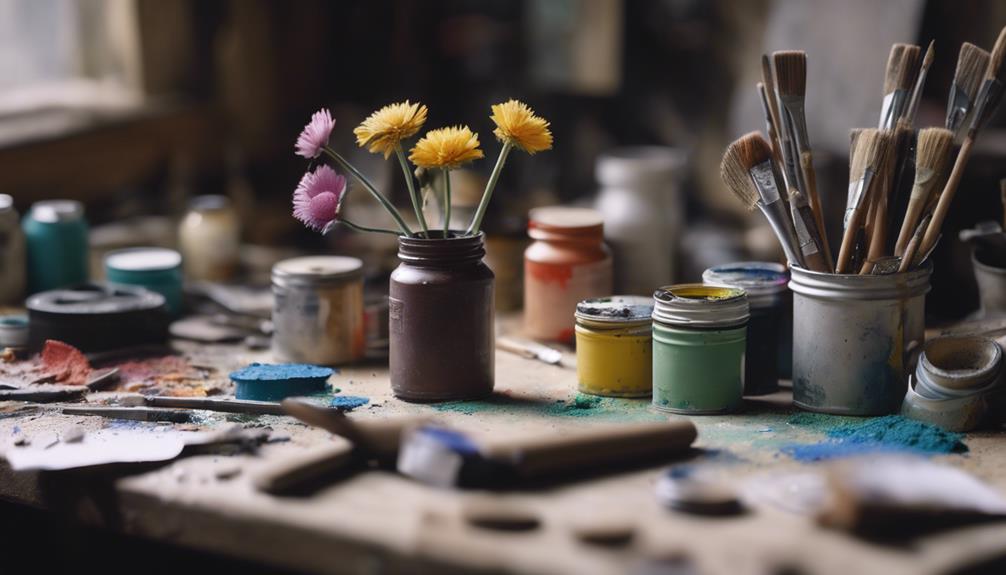
As we move forward with fixing imperfections and damage, we'll focus on tackling specific issues that can make or break the final result.
We'll start by addressing scratches, holes, and gaps – those pesky imperfections that can detract from our thrifted treasures' beauty.
Sanding Out Scratches
By gently sanding out scratches on our thrifted finds, we can uncover the hidden beauty beneath the imperfections and damage. It's a great day when we can transform a worn-out piece into a stunning treasure! With fine-grit sandpaper, we can smooth out those unsightly scratches, removing the visual noise that detracts from the item's original charm.
We'd look at our thrifted treasures with fresh eyes, imagining the possibilities. To sand effectively, we move in circular motions, avoiding noticeable patterns or lines on the surface. After sanding, a quick wipe-down with a damp cloth removes any dust or debris, leaving the surface clean and ready for the next step.
With scratches gone, our thrifted treasures are now primed for painting or refinishing, giving them a fresh, updated look that's anything but dull and lackluster – more like a dash of salt and pepper to spice up our decor! By sanding out those scratches, we're one step closer to revealing the hidden gem within.
Filling Holes and Gaps
How do we tackle those pesky holes and gaps that can make our thrifted treasures look worn and tired? We're about to find out! Filling holes and gaps is an important step in transforming our thrifted finds into fabulous pieces.
Here's what we do:
- Fill the gaps: We use wood filler, putty, or spackling compound to fill in those unwanted holes and gaps.
- Sand it smooth: We sand down the filled areas to create a smooth surface for painting.
- Prime for perfection: We apply a primer to guarantee better adhesion and coverage over the repaired areas.
- Paint it pretty: Finally, we choose a high-quality paint that matches the item's material for a seamless finish.
Sanding for a Smooth Finish
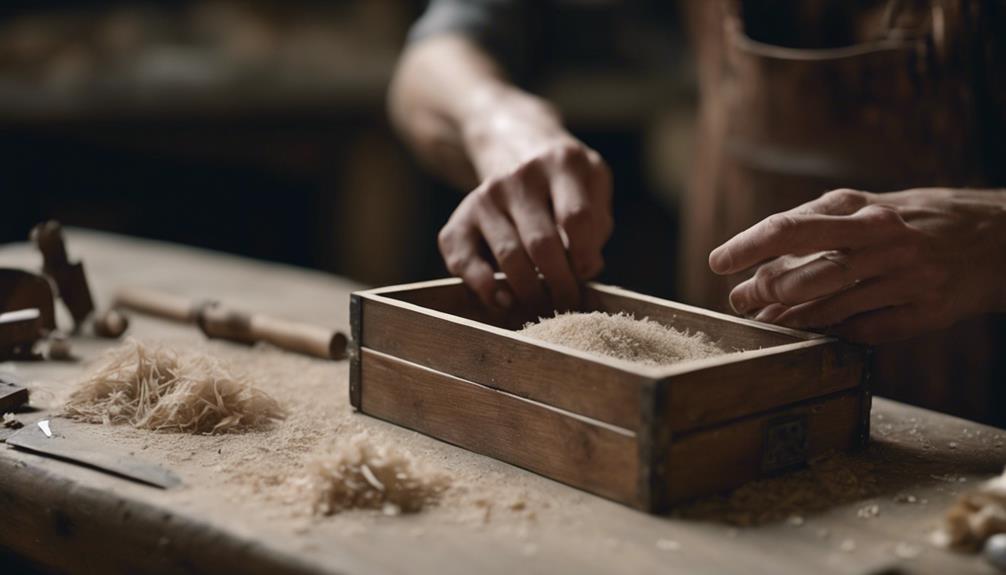
As we progress with transforming our thrifted treasures, we're now at the vital step of sanding for a smooth finish.
We'll explore the essential techniques for removing old finishes, mastering sanding methods, and smoothing out imperfections to create a flawless canvas for painting.
Removing Old Finishes
We tackle the essential task of removing old finishes, a painstaking process that demands patience and elbow grease, but yields a smooth canvas for our artistic vision. We thought I'd struggle with this step, but with the right tools and techniques, it's more manageable than we expected.
To remove old finishes effectively, we follow a few key steps:
- Choose the right grit: We use sandpaper with a grit between 80-120 for initial sanding to remove the existing finish effectively.
- Sand in the right direction: We make sure to sand in the direction of the wood grain to avoid damaging the piece and achieve a professional-looking finish.
- Gradually move to finer grits: We follow up with a finer grit sandpaper, around 220-320, to further smooth out the surface before painting.
- Be patient and persistent: We're going to put in the effort required to achieve a smooth surface, and the end result will be worth it.
Sanding Techniques Explained
What's the secret to achieving a silky smooth finish on our thrifted treasures – it all boils down to mastering the art of sanding! We're going to put in the effort to get it right, and it's worth it.
I'm just going to say it: sanding is vital in preparing our thrifted items for painting. We use sandpaper with a grit between 120-220 to create a smooth surface for the paint to stick to. We start sanding in a circular motion to remove imperfections and rough spots on the surface of the item.
After the initial sanding, we switch to a finer grit sandpaper (220-400) to achieve a finer finish and make sure the paint goes on smoothly. Remember, we're not just sanding for the sake of it – we're doing it to get that perfect finish.
I'm going to emphasize this: don't skip the final wipe-down with a damp cloth to remove any dust or debris before beginning the painting process. By following these simple steps, we'll be well on our way to a beautifully painted thrifted treasure that's sure to impress!
Smoothing Out Imperfections
Now that we've got our sanding techniques down pat, let's focus on smoothing out those imperfections that can make or break our paint job. Sanding is an essential step in preparing our thrifted items for painting, as it smooths out imperfections like rough surfaces and old finishes.
To achieve a smooth finish, we need to:
- Use fine-grit sandpaper to gently buff away any rough spots or flaking paint on the item.
- Sand in a well-ventilated area to avoid inhaling dust and debris.
- Clean the item thoroughly after sanding to remove any dust or debris before applying primer and paint.
- Repeat the sanding process as needed until the surface is smooth to the touch.
Priming for Better Adhesion
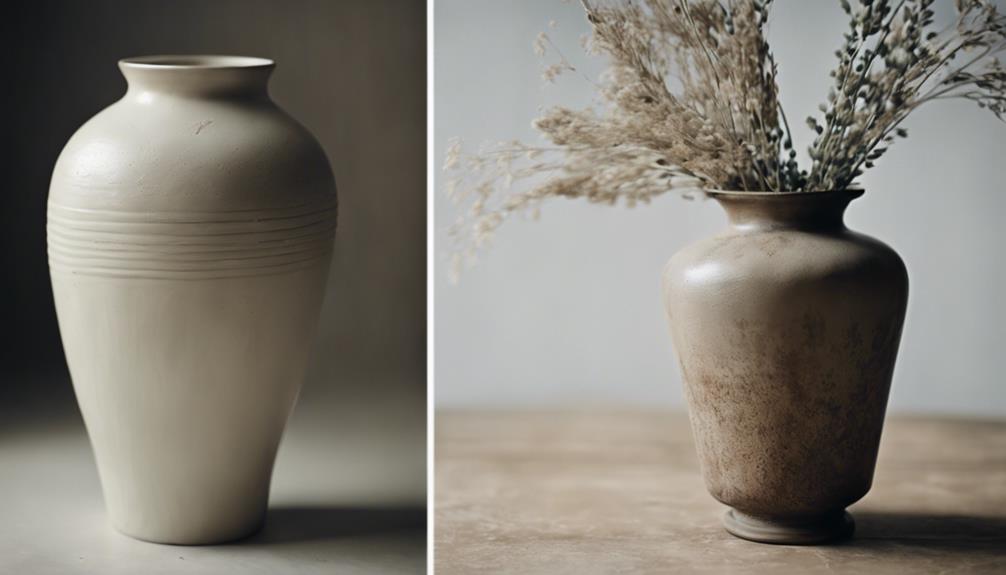
Before we delve into the world of color, an essential step in transforming our thrifted treasures is priming for better adhesion, establishing a strong bond between the paint and the surface.
We've smoothed out imperfections, and now it's time to create a solid foundation for our paint to adhere to. By applying a primer, we're securing a smooth and uniform base that allows the paint to stick better, reducing the chances of chipping or peeling over time.
With various types of primers available, such as oil-based, water-based, and shellac-based, we can choose the right one for our specific project. Proper priming not only enhances the durability of our painted finish but also ensures a longer lifespan.
We're not just slapping on some paint; we're creating a work of art that will last. By taking the time to prime our thrifted treasures, we're setting ourselves up for success and ensuring a beautiful, long-lasting finish.
Choosing the Right Paint Colors

With our thrifted treasures primed and ready, we're free to spark our creativity and choose the perfect paint colors to bring our unique visions to life. Now, it's time to unleash our inner artist and select the ideal hues to transform our finds into stunning pieces.
To guarantee our masterpieces blend seamlessly into our space, we'll consider the following essential factors when choosing paint colors:
- Existing color scheme: Guarantee our thrifted treasures complement the surrounding decor by selecting colors that harmonize with the existing palette.
- Neutral tones: Opt for timeless, versatile shades like white, black, or gray for a chic, sophisticated look.
- Bold statements: Experiment with vibrant colors to add a pop of personality to our decor.
- Test and compare: Use color swatches or paint samples to test and compare different shades before committing to the perfect hue.
Applying the First Coat of Paint
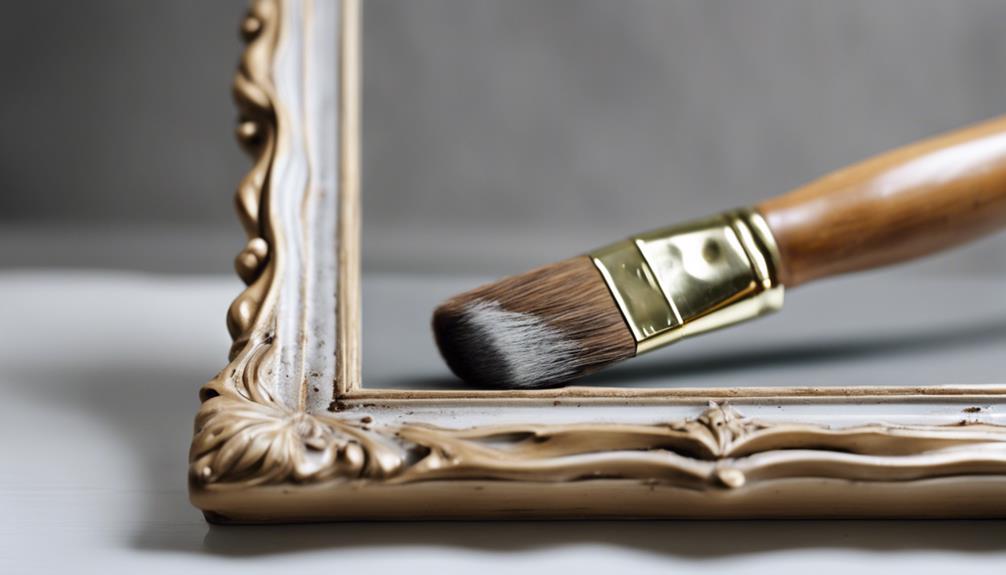
We grab our paintbrushes, ready to transform our thrifted treasures as we apply the first coat of paint, carefully guaranteeing a smooth, even layer that sets the tone for our creative vision.
Before we begin, we make sure our item is clean and dry, free of any dirt or debris that might affect the paint's adhesion. If our item is made of a material that may not take paint well, like metal or plastic, we use a primer to establish a strong bond.
Then, we choose our painting method – either a brush for a more textured look or spray paint for a smooth finish. We apply the paint evenly, working in sections to maintain consistency. It's crucial to let the first coat dry completely before adding more coats, as this helps build a durable, opaque finish.
To streamline the process, we can opt for a paint with a built-in primer, saving us time and effort. With our first coat applied, we're one step closer to revealing our thrifted treasure's hidden beauty.
Adding Additional Coats and Texture
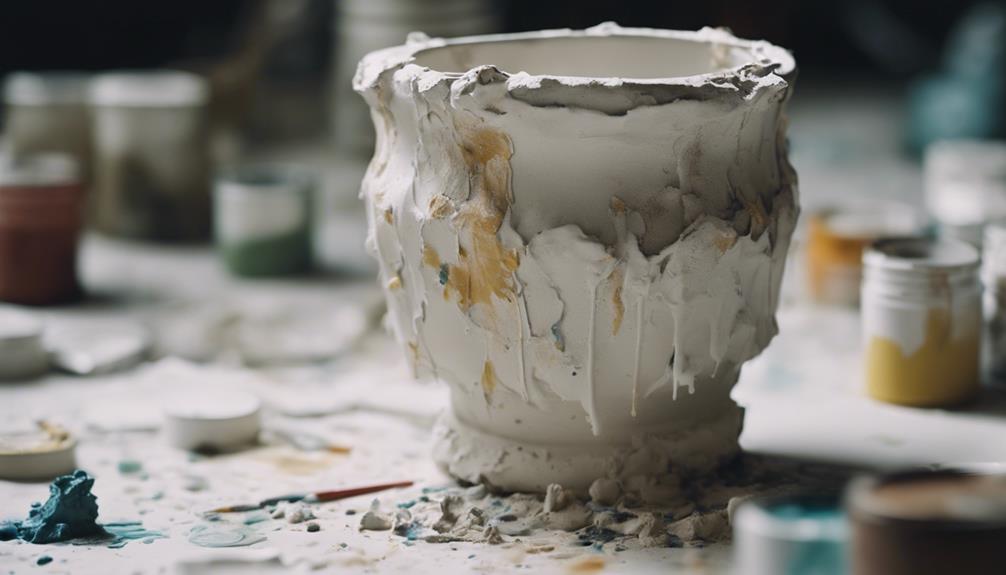
Now that we've achieved a smooth, even base coat, it's time to build on that foundation by adding additional coats of paint to really make our thrifted treasures pop with color and texture.
To take our pieces to the next level, we can experiment with different painting techniques and tools. Here are some ways to add texture and interest:
- Dry brushing: Use an almost-dry brush to create a rough, textured look.
- Stippling: Create a pattern of small dots to add depth and visual interest.
- Multi-color magic: Use multiple colors or shades to create a layered, interesting look.
- Toolbox treasures: Experiment with different tools like sponges, stencils, or even household items to create unique textures and patterns.
Remember to let each coat dry completely before applying the next layer to prevent smudging or mixing of colors.
Sealing With a Protective Finish

As we near the finish line in transforming our thrifted treasures, we're taking an essential step in ensuring their beauty lasts – sealing them with a protective finish.
We'll explore the different types of finishes available, from clear coat sprays to waxes and varnishes, and discuss how to choose the right one for our unique pieces.
Finishing Touches Applied
With our paint fully dry, we apply a protective finish to seal in our hard work and guarantee our thrifted treasure remains vibrant and chip-resistant for years to come. This important step ensures our masterpiece stays looking fabulous, even with regular use.
To achieve a flawless finish, we follow these essential steps:
- Wait for the paint to dry completely: Avoid applying the protective finish too soon, as it can cause smudges and imperfections.
- Choose the right finish: Select from varnish, polyurethane, or wax, depending on the desired look and level of protection.
- Use a high-quality applicator: A good brush or applicator ensures a smooth, even application.
- Follow the manufacturer's drying instructions: Allow the protective finish to dry and cure according to the instructions to ensure a strong, long-lasting bond.
Protective Coatings Explained
We explore the world of protective coatings, examining the various options available to seal our thrifted treasures and guarantee their painted beauty lasts for years to come. When it comes to protecting our painted masterpieces, we have several options to choose from.
| Coating Type | Characteristics | Best For |
|---|---|---|
| Polyurethane | Durable, waterproof | High-traffic items, furniture |
| Varnish | Glossy, protective | Wood surfaces, decorative items |
| Lacquer | Fast-drying, protective | Quick projects, small items |
| Wax | Natural, subtle sheen | Distressed, vintage finishes |
| Shellac | Natural, high-gloss | Fine furniture, antiques |
Sealant Options Compared
We've explored the importance of protective coatings, and now it's time to explore the diverse range of sealant options available to finalize our painted thrifted treasures. With so many choices, it can be overwhelming, but don't fret, we've you protected!
Here are some popular sealant options to ponder:
- Acrylic sealants: Provide a clear, glossy finish that safeguards painted surfaces from moisture and UV rays.
- Polyurethane sealants: Offer a durable, water-resistant coating suitable for high-traffic areas or outdoor use.
- Mod Podge sealants: Are versatile and can be used for both sealing and decoupaging, providing a smooth, matte finish.
- Spray sealants: Like clear enamel or varnish, offer quick and easy application for a protective coat on painted items.
When choosing a sealant, contemplate the desired finish, level of protection needed, and the type of surface being sealed.
Adding Final Embellishments
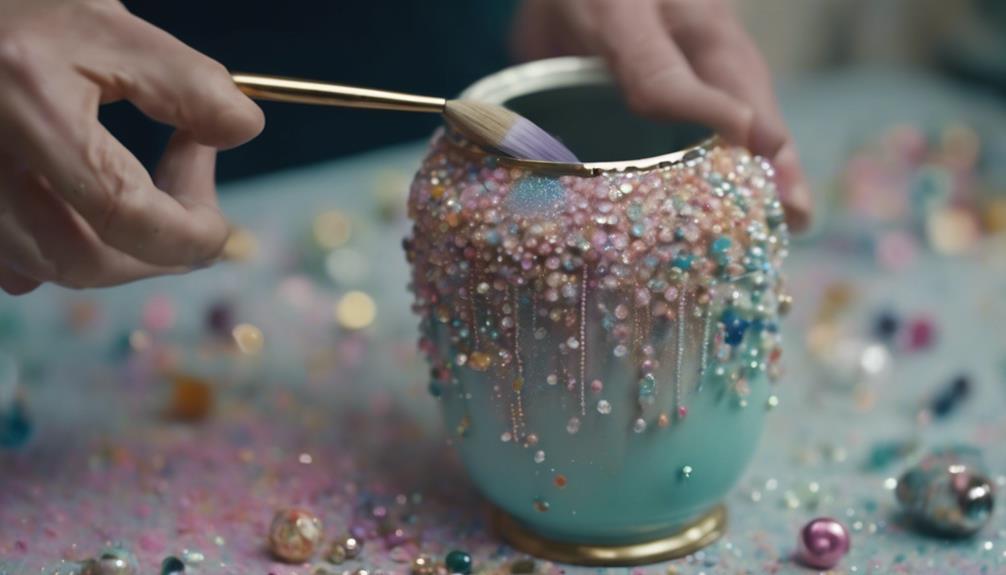
As we put the finishing touches on our thrifted treasure, a few carefully chosen embellishments can elevate our painted masterpiece from ordinary to extraordinary.
We can add a touch of elegance with ribbon, lace, or twine, or go for glamour with metallic or glitter paint.
For a more personalized look, we can attach small embellishments like beads, sequins, or charms to make our piece truly unique.
If we want to add intricate designs or patterns, stencils or decals are a great option.
Frequently Asked Questions
Can I Use Regular Household Cleaners to Prep My Thrifted Find?
We can't emphasize this enough: avoid using regular household cleaners to prep your thrifted find! They can leave residues that interfere with paint adhesion or even damage the surface.
Instead, we opt for gentle cleaners specifically designed for cleaning surfaces before painting. These products guarantee a clean slate for our paint to adhere to, resulting in a flawless finish.
Trust us, it's worth the extra effort to get it right!
How Do I Prevent Paint From Chipping off After It Dries?
We've all been there – you spend hours perfecting your paint job, only to have it chip off shortly after.
To guarantee this, we make sure to properly prep our surface, using a primer if necessary. Then, we apply a coat of varnish or sealant to protect the paint and create a barrier against wear and tear.
This extra step secures our hard work doesn't chip away, and our thrifted find stays fabulous for longer.
Are There Any Eco-Friendly or Low-Voc Paint Options Available?
We're happy to report that yes, there are eco-friendly and low-VOC (volatile organic compound) paint options available. Many brands now offer environmentally responsible choices that minimize indoor air pollution and reduce environmental impact.
Look for labels like Greenguard Gold or California Air Resources Board (CARB) compliant, which guarantee the paint meets strict standards for low chemical emissions.
Can I Mix Different Brands of Paint for a Unique Color?
We've wondered if we can mix different brands of paint to create a one-of-a-kind color. The answer is yes, but with caution. Since different brands may have varying formulations, it's essential to test the mixture on a small, inconspicuous area first.
If the paint combines smoothly and dries evenly, you're good to go! However, if it separates or forms lumps, it's best to stick with a single brand for a consistent finish.
Will a Topcoat Protect My Artwork From Fading in Sunlight?
It's understandable that one might assume a topcoat is a foolproof solution to fading, but it's not that simple. The reality is, a topcoat can help protect our artwork from sunlight, but it's not a guarantee.
UV rays can still cause colors to fade over time, even with a topcoat. That being said, a good topcoat can definitely provide some protection. Look for one that specifically states it offers UV protection and follows the manufacturer's instructions for application.
Conclusion
To sum up, painting thrifted treasures can transform them from drab to fab with just a few simple steps.
Did you know that up to 95% of thrifted items can be repurposed with a fresh coat of paint?
By following these 10 steps, you can breathe new life into your thrifted finds and create unique pieces for your home.
So next time you're browsing at the thrift store, keep in mind the potential for a DIY paint makeover!
Home Decor
August Color Palettes That Will Transform Your Home – Try Them Today!
Discover vibrant August color palettes that can transform your home, but wait until you see the unexpected accents that will elevate your space!
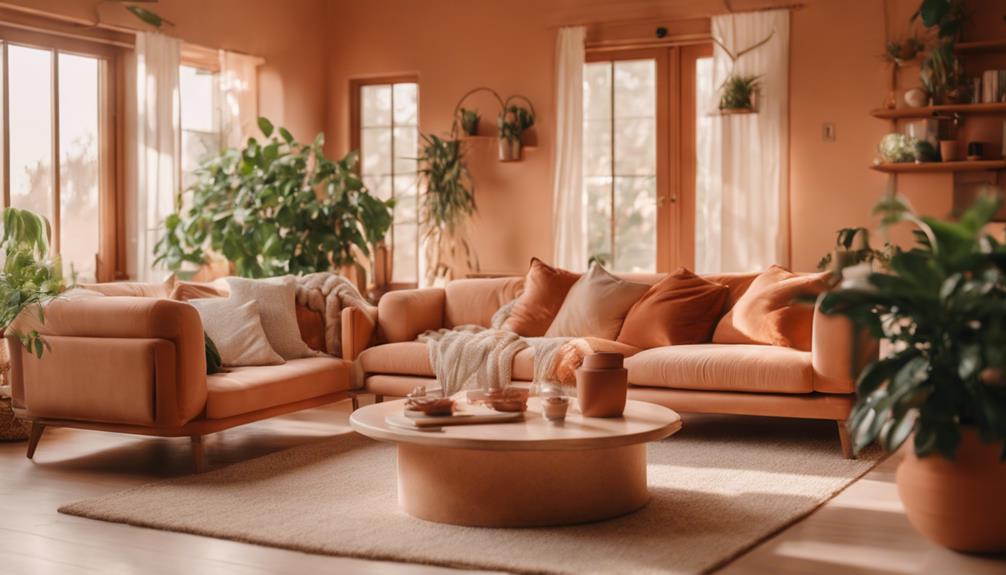
Looking to transform your home this August? Embrace vibrant color palettes to ignite your space. Start with Pink Dawn as your bold centerpiece, complemented by Symphony Blue and Jamaican Aqua for a lively mix. Adding white brings balance, while gold accents and natural elements enhance the bohemian vibes. Don't shy away from incorporating hot pink accents in unexpected places—like kitchens and bathrooms. This combination energizes your decor without overwhelming it. With these ideas, you're well on your way to creating a fresh atmosphere. Stick around, and you'll discover even more tips to elevate your home's style!
Key Takeaways
- Embrace vibrant hues like Pink Dawn, Symphony Blue, and Jamaican Aqua to energize your living spaces this August.
- Incorporate white accents for visual balance, enhancing the overall aesthetic of your decor.
- Use gold accents and natural elements to add a bohemian flair to your interior design.
- Experiment with layering colorful rugs and throw pillows for a cozy, inviting atmosphere.
Embracing Color Trends
Embracing color trends means welcoming vibrant hues like pink into your home, transforming spaces with a fresh and expressive flair. As you explore the emerging dominance of pink, consider how it can redefine your design aesthetic. This isn't just any pink—Millennial Pink is leading the charge, reflecting a cultural shift towards embracing bold colors in home decor.
To create a harmonious environment, start by developing a mood board that features August's color palette. Incorporate Pink Dawn as your main shade, pairing it with Symphony Blue and Jamaican Aqua. This combination will breathe life into your rooms, moving away from traditional neutrals and adding a lively touch.
Don't forget to enhance your design with gold accents and natural elements. These additions can elevate the overall aesthetic, making your space feel more inviting and textured.
August's Signature Color Palette
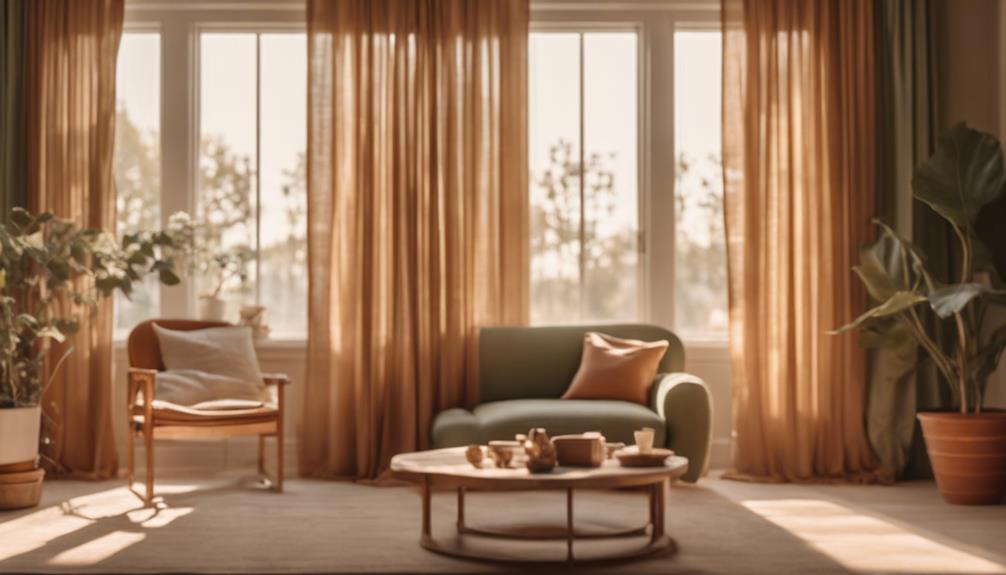
August's signature color palette showcases Pink Dawn as the vibrant centerpiece, offering versatility for walls or ceilings. This striking shade isn't just a trend; it's a reflection of how colors have evolved over the years. You can easily transform a space by incorporating this bold pink into your decor.
Complementing Pink Dawn, Symphony Blue and Jamaican Aqua provide invigorating tones that breathe life into your rooms. These colors create a soothing contrast while remaining in harmony with the energetic pink. Adding white enhances visual balance, allowing the vibrant Pink Dawn to shine even more.
To elevate the overall look, consider incorporating gold accents and natural elements like orchids and hibiscus. These touches bring a bohemian flair, making your home feel both stylish and inviting.
This color palette not only embraces current trends but also encourages you to think outside the box when it comes to color choices.
Personal Reflections on Pink
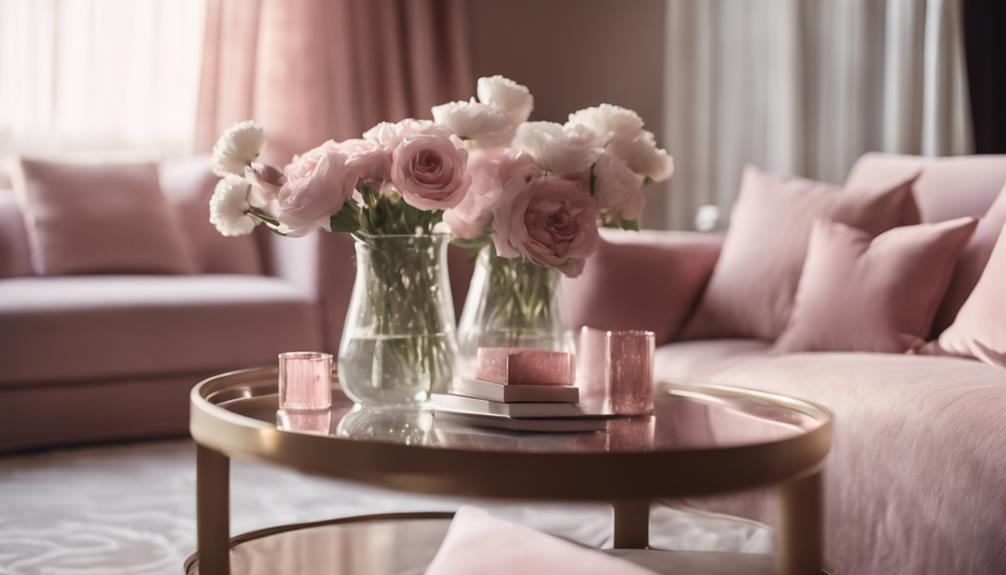
You might find your feelings about pink have changed over time, especially as life events influence your color preferences.
Once seen as just a childish hue, pink can now represent a bold choice in your home decor.
As you embrace brighter shades, consider how these shifts reflect your personal journey and evolving taste.
Journey to Embrace Pink
The journey to appreciate pink unfolded unexpectedly after welcoming a daughter, transforming my initial resistance into a vibrant acceptance of the color. You might find that your own experiences color your perspective, just as mine did.
While I once shied away from pink, especially pastel shades, I embraced hot pink with enthusiasm. It became a bold statement in my wardrobe and home decor.
Incorporating pink hasn't only brightened my space but also reflected a broader cultural shift towards more dynamic colors. You may notice this trend too, where blush tones are predicted to dominate upcoming fall palettes. This evolution in taste showcases how personal experiences can reshape our preferences.
Consider these aspects of your journey with pink:
- The emotional connections tied to specific colors
- The influence of personal milestones, like having children
- The shift in societal color trends
- The contrast between pastel and vibrant shades
Embracing pink, particularly in its bolder forms, can reinvigorate your surroundings and enrich your experiences. So why not take a chance on this lively hue?
Personal Color Preferences Shift
As life experiences unfolded, personal color preferences shifted dramatically, illustrating how our journeys can reshape our views on hues like pink. You might remember a time when pastel pink felt like a color to avoid, steeped in negative memories. However, welcoming a daughter into your life can change everything. Suddenly, the softness of pink transforms from something you resist to a color that carries warmth and joy.
Though pastel shades still don't resonate with you, vibrant hues like hot pink have found a place in your heart. This shift isn't just about embracing a new color; it represents a deeper evolution in your taste. You've slowly woven pink into your wardrobe and home, reflecting your changing perspective.
In this broader context, it's fascinating to see how cultural trends, like the rise of Millennial Pink, resonate with your own transformation. Your journey with pink showcases the power of personal experiences in shaping color preferences and design choices. By allowing yourself to explore the spectrum of pink, you reveal a vibrant part of your identity, demonstrating that even our color preferences can grow and evolve over time.
Pink in Home Decor
Embracing pink in home decor has transformed my living space into a vibrant reflection of my evolving taste, blending warmth and joy in unexpected ways. Initially, I resisted pastel shades due to their associations, but after welcoming a daughter, my perspective shifted. Now, I lean towards bold, vibrant shades like hot pink that energize my space while steering clear of softer pastels.
Integrating pink into my decor has revealed its versatility, allowing me to create a dynamic atmosphere. As pink gains popularity, especially Millennial Pink, it signifies a cultural shift towards bolder choices in home design. Engaging in conversations with others, I've discovered diverse opinions on how striking pink can be, particularly when paired with other colors like gray.
Here are some ways to incorporate pink into your home decor:
- Use hot pink throw pillows to add a pop of color to neutral sofas.
- Paint an accent wall in a bold pink to create a focal point.
- Accessorize with pink artwork that complements your existing decor.
- Choose vibrant pink rugs to enliven your floors.
Explore the transformative power of pink and see where it takes you!
Bohemian Decor Essentials
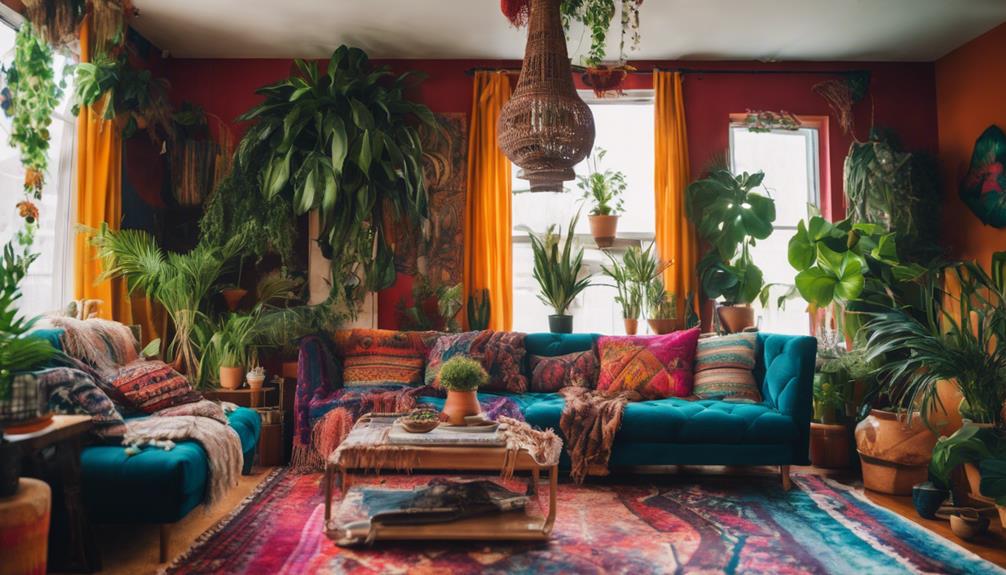
How can you transform your space into a vibrant bohemian haven filled with personality and warmth? Start by embracing a lively mix of colors, patterns, and textures that reflect your unique style.
Layer colorful rugs and throw pillows to create a cozy atmosphere. These textiles not only add depth but also enhance the eclectic feel that defines bohemian decor.
Incorporate plants like orchids and hibiscus to breathe life into your home. These natural elements connect your space to the outdoors, making it feel fresh and inviting.
Don't forget to include diverse materials such as wood, metal, and woven elements; they contribute to the layered look that's essential in bohemian design.
Curate your space with unique art pieces and decor items collected from travels or local markets. These treasures tell your story and showcase your individuality.
The key to a successful bohemian vibe is personalization, so let your creativity shine through every aspect of your decor. Mix and match until you find the perfect balance that reflects your personality, and you'll create a warm, vibrant sanctuary that feels truly like home.
Community Color Conversations
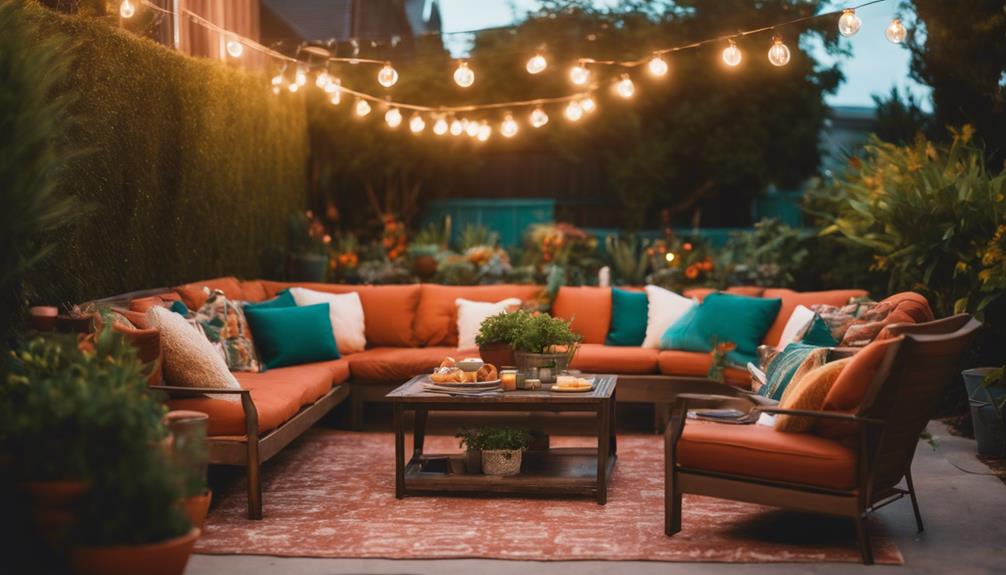
Let's talk about your color journey!
Share your favorite combinations and how you've used pink in your home decor.
Your experiences can spark inspiration for others in our vibrant community!
Share Your Color Journey
Sharing your color journey not only sparks inspiration but also builds a vibrant community where everyone can explore their unique tastes and preferences in home decor. Engaging with others about color choices fosters a rich dialogue and allows you to learn from diverse opinions. You might discover why pink resonates with some while gray appeals to others.
The comments section is a fantastic platform for exchanging insights and suggestions. You can share how you incorporated trending colors into your space or ask for advice on your current project. Plus, participating in monthly color challenges on social media lets you showcase your creativity and inspire others.
Here are some ways to enhance your color journey:
- Share photos of your color transformations.
- Discuss your favorite color palettes and why they speak to you.
- Offer tips on blending colors effectively in your home.
- Invite friends to join in on color challenges.
Favorite Color Combinations
Immerse yourself in the vibrant world of favorite color combinations, where each pairing tells a story and reflects personal style. In this community, you'll discover a treasure trove of color palettes that resonate with diverse preferences and experiences. Many members find joy in combining pink with complementary hues like Symphony Blue and Jamaican Aqua, creating lively atmospheres that are both modern and inviting.
As you explore these combinations, you'll notice the emotional connections people have with their chosen colors. Each story shared can inspire you to think differently about your own color choices. The ongoing dialogue encourages you to experiment with new palettes, fostering creativity in your home decor.
Don't shy away from expressing your own favorites! The community thrives on feedback and shared experiences, making it a welcoming space for everyone. Whether you're drawn to soft pastels or bold contrasts, there's a combination waiting for you to investigate.
Plunge into these conversations, and you might just find the perfect palette that transforms your living space into a reflection of your unique style. Embrace the journey and let your home shine with colors that speak to you!
Pink in Home Decor
As you explore favorite color combinations, you'll find that pink is making a bold statement in home decor, capturing attention with its versatility and warmth. This year, Blush is set to dominate fall color palettes, reflecting a cultural shift towards vibrant choices. You'll notice Pink Dawn as a key player in August's palette, beautifully complemented by Symphony Blue and Jamaican Aqua.
Homeowners are increasingly embracing pink, moving from a dislike of pastels to celebrating bolder shades like hot pink. This transformation is especially evident in bohemian aesthetics, where pink is integrated with textiles, plants, and natural materials to create an inviting atmosphere.
Consider these ideas to incorporate pink into your decor:
- Pair pink with neutral tones like gray for a sophisticated look.
- Use hot pink accents to energize a room without overwhelming it.
- Incorporate pink textiles, like throw pillows or rugs, to add warmth.
- Combine pink with vibrant greens to enhance a natural feel.
Embrace the versatility of pink, and watch your space transform into a vibrant haven!
Seasonal Decorating Tips
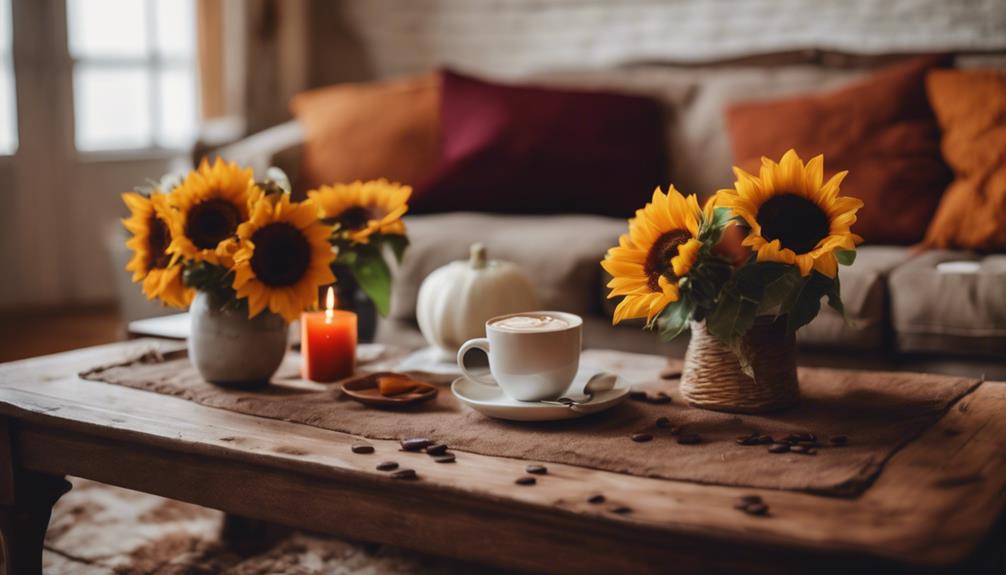
Transform your space with seasonal colors that reflect the vibrant energy of August, using shades like Pink Dawn, Symphony Blue, and Jamaican Aqua. These hues not only create a rejuvenating ambiance but also energize your home decor during the summer months.
To enhance this look, consider adding white accents alongside pink, as they provide visual balance and highlight the vibrant tones in your decor. Incorporate gold accents and natural elements like greenery to add texture and interest, contributing to a bohemian aesthetic that flourishes in warm weather.
Rotating seasonal colors in textiles, such as throw pillows and blankets, can effortlessly revitalize your home while creating a cozy atmosphere that resonates with August's spirit. Don't overlook the impact of small changes; introducing plants like orchids and hibiscus can greatly enhance the vibrancy of your living spaces.
These elements bring life and a touch of nature indoors, making your home feel more inviting. By embracing these seasonal decorating tips, you'll capture the essence of August and transform your home into a stylish, lively retreat. Get ready to enjoy the beauty of summer right inside your own space!
Resources for Color Inspiration
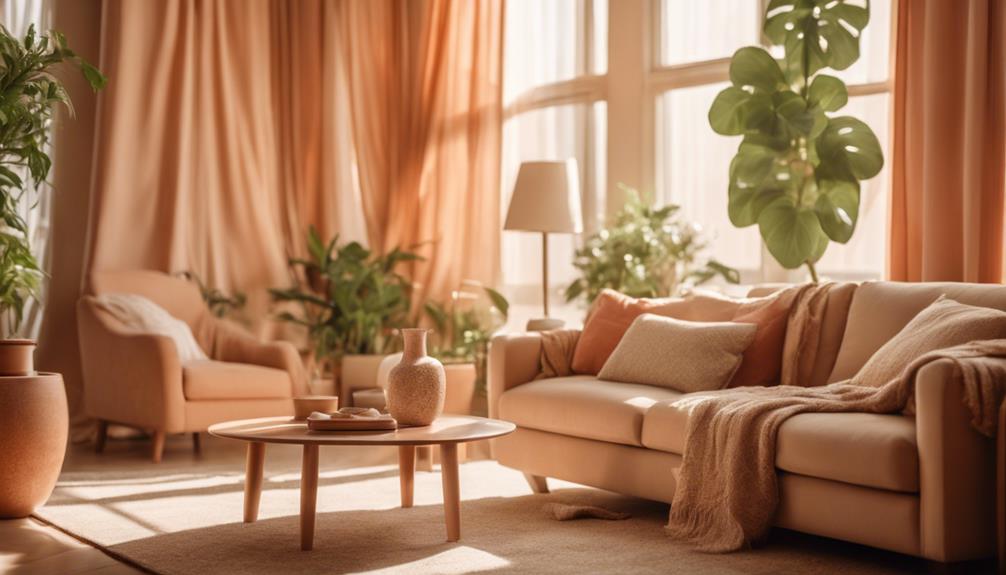
To find the perfect color inspiration for your home, explore a variety of resources that cater to your unique style and preferences. With the right tools and communities at your fingertips, you'll discover palettes that resonate with you and elevate your space.
- Color analysis tools: Use free quizzes to determine your personal color types, helping you enhance your style.
- Pinterest: Browse for downloadable resources like color palettes and wheels to aid in planning your color combinations.
- Social media challenges: Participate in weekly color challenges on platforms like Instagram and Facebook to engage with fellow color enthusiasts and share your journey.
- Blogs: Access insightful blog posts that offer tips on choosing paint colors, considering color psychology, and exploring trending hues for home decor inspiration.
Frequently Asked Questions
What Are the Colors for the Month of August?
For August, you've got Pink Dawn as the main color, paired with Symphony Blue and Jamaican Aqua for cool accents. Adding white creates balance, while gold accents and greenery enhance the overall vibe beautifully.
What Color Goes Best With August?
Did you know that 60% of people feel more relaxed in pink environments? For August, consider pairing Pink Dawn with Symphony Blue and Jamaican Aqua. They create a vibrant yet calming atmosphere in your space.
How Do I Choose a Color Palette for My New Home?
To choose a color palette for your new home, start with a main color you love. Then, select complementary shades and neutrals, adding accents to enhance the overall look while ensuring harmony throughout your space.
What Colors Are Associated With Months?
Colors associated with months reflect seasonal changes. For example, January features white, February has cherry red and pink, March boasts emerald green and purple, while August embraces burnt red and orange, signaling summer's shift into autumn.
Conclusion
As you stand in your living room, imagine the vibrant hues of August washing over your walls.
Picture how a bold pink can breathe life into your space, while soft neutrals create a serene backdrop.
The warmth of bohemian accents draws you in, inviting you to explore every corner.
So, are you ready to transform your home and embrace these enchanting color palettes?
The perfect shade awaits you—just step into your vision and let the magic unfold.
Alfresco
What Is Alfresco Painting? Artistic Techniques Explained!
An exploration of alfresco painting, a historical technique rooted in the Renaissance, revealing artistic secrets that elevate outdoor artistry.

Explore the historical artistry of alfresco painting, stemming from the Renaissance in Italy. Artists like Giotto and Michelangelo led the way, painting on wet plaster to craft vivid frescoes. For this technique, you'll need outdoor-grade paints such as oil paints, acrylics, or watercolors, along with suitable brushes and water containers. Prepping the plaster surface meticulously is essential for a flawless finish. As you paint, remember to use soft brushes on wet plaster, allowing pigments to chemically bond with the surface for depth. Delve into this technique further to uncover the intricate details and techniques that make alfresco painting truly unique.
Key Takeaways
- Originates from Renaissance Italy, involving painting on wet plaster.
- Requires outdoor-grade paints, suitable brushes, water containers, and portable easels.
- Involves drawing directly on wet plaster and using soft brushes for blending.
- Fresh plaster crucial for strong paint bonding, vibrant colors, and longevity.
- Preservation entails curing, sealing, weather considerations, and regular maintenance.
Origins of Alfresco Painting
The origins of alfresco painting trace back to Italy during the Renaissance period, where artists pioneered the technique of painting on wet plaster to create enduring murals. This artistic practice, known as fresco, emerged as a popular method for decorating the walls and ceilings of churches, palaces, and public buildings in Italy.
During the Italian Renaissance, artists like Giotto and Michelangelo utilized fresco painting to produce magnificent works of art that showcased both their technical skill and creative vision.
Fresco painting involves applying water-based pigments on freshly laid wet plaster, allowing the colors to become an integral part of the surface as they dry. Artists would transfer their designs onto the wet plaster from a cartoon or outline drawing, enabling them to create intricate and long-lasting murals.
This technique not only provided a durable finish but also allowed for the creation of monumental and detailed artworks that adorned various architectural settings, contributing to the rich artistic legacy of the Italian Renaissance.
Materials Needed for Alfresco Painting
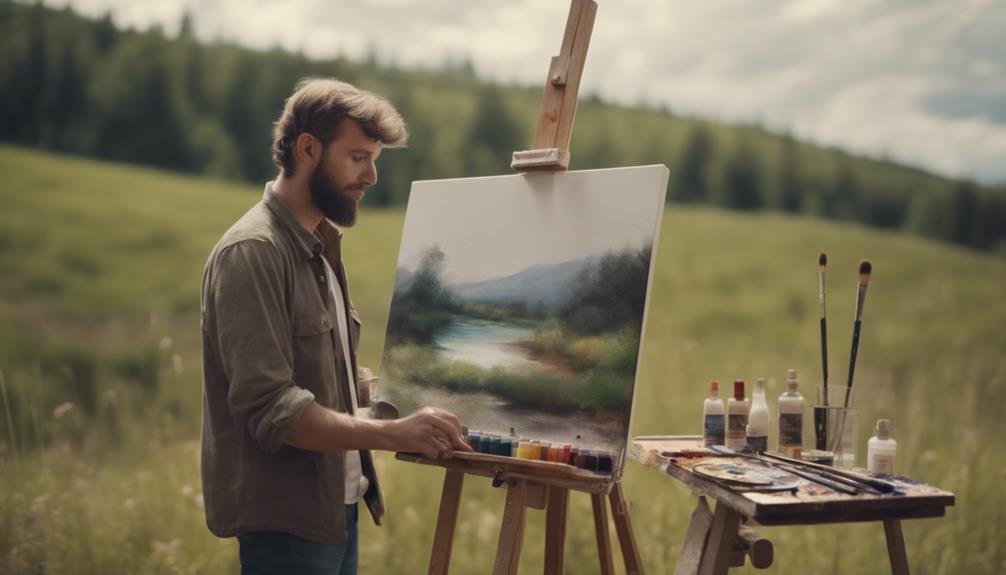
For alfresco painting, you'll need specific materials to create your artwork outdoors. Common materials for fresco painting include outdoor-grade paints such as oil paints, acrylics, or watercolors. These paints are chosen based on the artist's preferences and the desired effect.
In addition to paints, you'll require brushes suitable for outdoor use, water containers for mixing paints, and portable easels to support your canvas or surface.
When painting alfresco, the natural light and surroundings play a significant role in influencing the colors and atmosphere of your artwork. This medium allows artists to capture changing light, shadows, and textures in real-time, providing a unique artistic experience.
Remember that preparing the plaster surface adequately is essential before beginning your alfresco painting to maintain the longevity and quality of your artwork.
Preparing the Plaster Surface
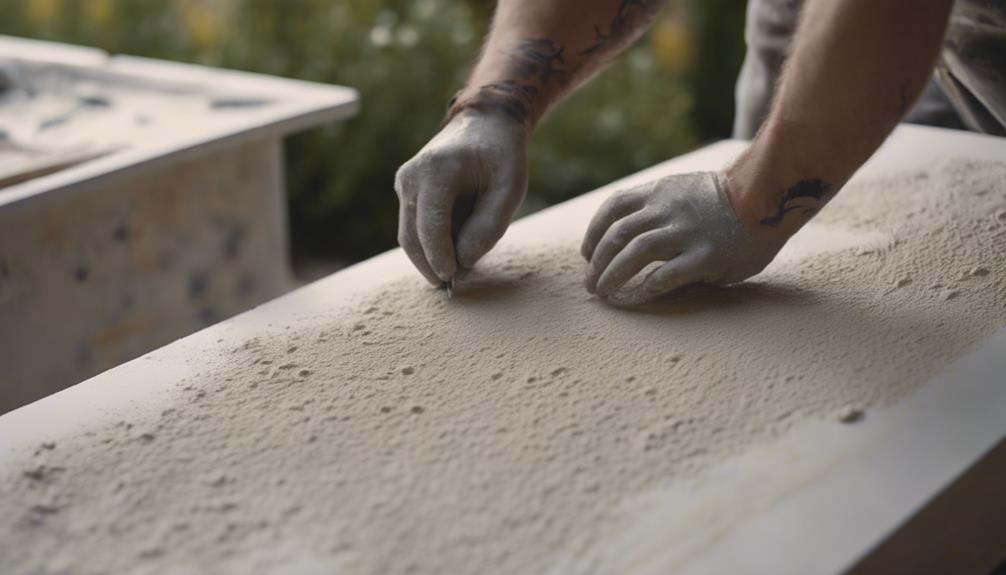
To start preparing the plaster surface for alfresco painting, ensure it's smooth and free of imperfections. This step is vital as the success of the painting relies heavily on the quality of the plaster surface.
Artists often employ traditional fresco techniques to achieve the desired smoothness and flawlessness required for alfresco painting. Ensuring the plaster surface is completely dry is essential before commencing the painting process, as any moisture can compromise the adhesion of the pigments to the surface.
Properly preparing the plaster surface not only enhances the aesthetic appeal of the final artwork but also contributes to its longevity. By meticulously attending to the details of the plaster surface, artists set a strong foundation for the application of water-based pigments, which is the hallmark of alfresco painting.
Drawing the Design on Plaster
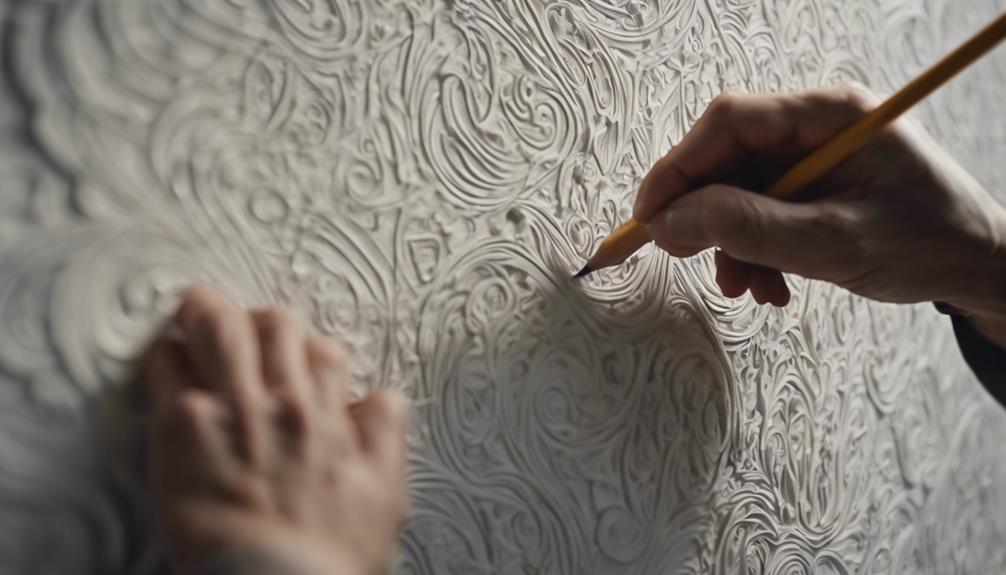
When drawing the design on plaster for alfresco painting, artists meticulously outline their vision directly onto the wet plaster surface. This technique for tracing serves as an essential guide for applying pigments and creating the mural.
Ensuring accuracy and cohesion in the final artwork, this step allows for the seamless integration of the design into the larger mural composition.
Plaster Design Preparation
Efficiently transferring the desired artwork onto the fresh plaster surface is a crucial step in the process of preparing the design for an alfresco painting. Artists utilize tools like brushes, pencils, or styluses to outline the design directly onto the prepared plaster surface.
These design outlines act as a roadmap for the artist, guiding them through the painting process in the alfresco technique. Precision and accuracy in this step are essential as they greatly impact the overall composition of the artwork.
Drawing the design on plaster marks the critical initial phase in creating vibrant and enduring alfresco paintings. By carefully tracing the design onto the plaster, artists lay the foundation for a visually captivating mural that withstands the test of time.
This meticulous process ensures that the artwork isn't only visually appealing but also structurally sound, enhancing its longevity and artistic impact.
Technique for Tracing
Using a sinopia sketch or cartoon, artists meticulously trace the design onto the fresh plaster surface to prepare for the alfresco painting process. Tracing is an essential step in fresco painting, as it allows artists to transfer the intricate details of their design onto the plaster with precision and accuracy.
By following the lines of the sketch or cartoon, artists can guarantee that the final composition reflects their original vision faithfully. This technique not only guides the artist during the painting process but also aids in the placement of elements within the composition. Through tracing, artists can achieve a level of detail and accuracy that would be challenging to attain freehand.
Ultimately, tracing plays a significant role in ensuring that the final fresco painting is a true representation of the intended design, capturing every nuance and detail with meticulous care.
Painting Techniques in Alfresco Painting
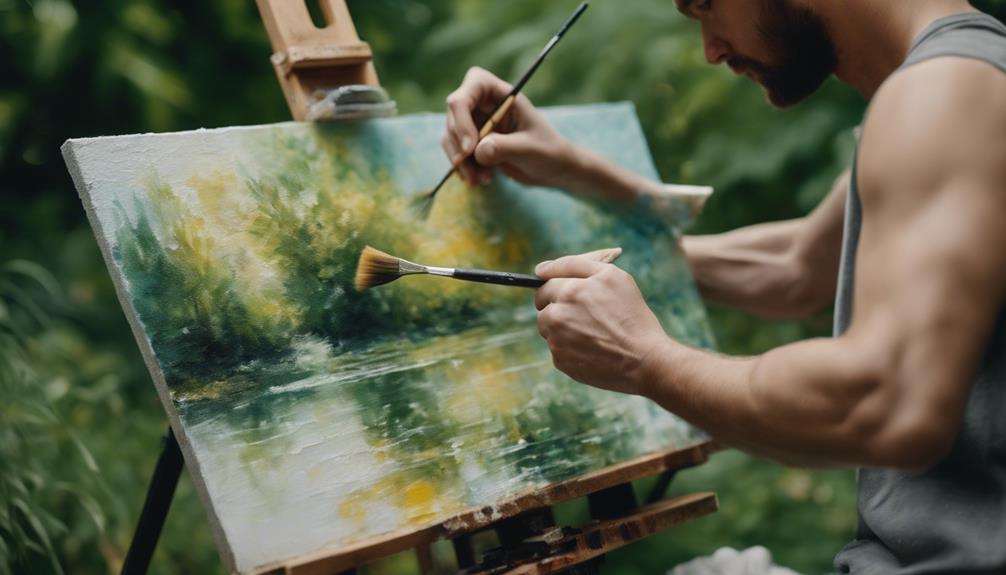
To achieve intricate details and vibrant colors in alfresco painting, artists employ specific brushwork techniques on the freshly applied plaster. Working on wet plaster allows the pigments to bond chemically with the surface, ensuring the artwork becomes a permanent part of the wall in mural painting.
The technique involves using soft brushes to apply pigments to the wet surface, with the colors becoming brighter as the plaster dries. Artists must work swiftly and confidently to capture the desired hues and textures before the plaster sets. By blending and layering pigments on the wet surface, they can achieve depth and dimension in the mural.
This method of painting on wet plaster gives the artwork a matte finish and durability that's ideal for large-scale murals. The process of painting on wet plaster requires skill and precision to create lasting and visually stunning pieces of art.
Importance of Fresh Plaster in Painting
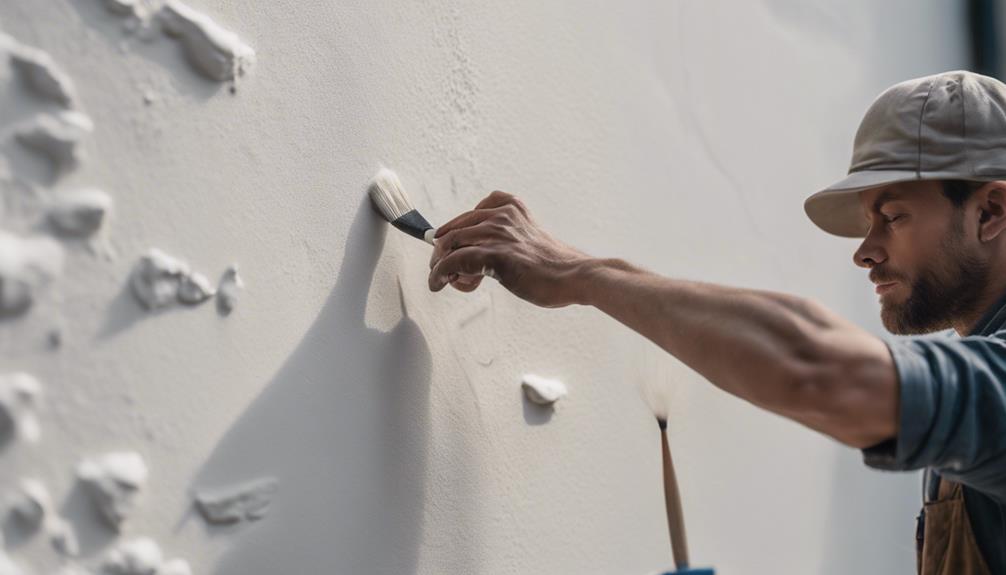
Fresh plaster plays a vital role in alfresco painting by ensuring that the paint adheres securely to the wall surface, enhancing its durability over time.
The porous nature of fresh plaster allows the pigments to be absorbed, creating a strong bond between the paint and the wall.
Artists find that painting on fresh plaster provides a smooth and receptive canvas for their artistic expression, resulting in vibrant and long-lasting colors on the wall.
Fresh Plaster Enhances
Enhancing the vibrancy and longevity of painted colors, fresh plaster plays an essential role in alfresco painting techniques. When working with fresco painting, fresh plaster acts as a pivotal foundation that allows the colors to bond effectively, creating lasting artwork. The porous nature of fresh plaster enhances the vibrancy of the colors, ensuring they remain vivid over time. Additionally, painting on fresh plaster provides artists with a smooth and even surface to work on, allowing for intricate details and precise brushwork.
To further illustrate the importance of fresh plaster in alfresco painting, consider the following table:
| Benefits of Fresh Plaster in Alfresco Painting |
|---|
| Allows colors to bond effectively |
| Enhances color vibrancy and longevity |
| Provides a smooth surface for detailed work |
Painting Adhesion and Durability
For ideal adhesion and durability in alfresco painting, fresh plaster plays a critical role in bonding water-based pigments to the wall surface. In fresco painting, the application of fresh plaster serves as the foundation for the paint to guarantee effective bonding, ensuring a long-lasting finish.
The interaction between the fresh plaster and water-based pigments is essential for creating a strong bond that withstands the test of time. Without the use of fresh plaster, the paint may not properly set on the wall surface, leading to potential issues such as flaking or peeling over time.
Fresh plaster in alfresco painting isn't just a surface preparation step but a fundamental component in enhancing the vibrancy and longevity of the colors applied. It allows for a seamless integration of the paint into the wall, becoming a permanent part of the structure.
The meticulous attention to using fresh plaster guarantees a durable and visually striking outcome in fresco painting.
Curing and Sealing the Fresco
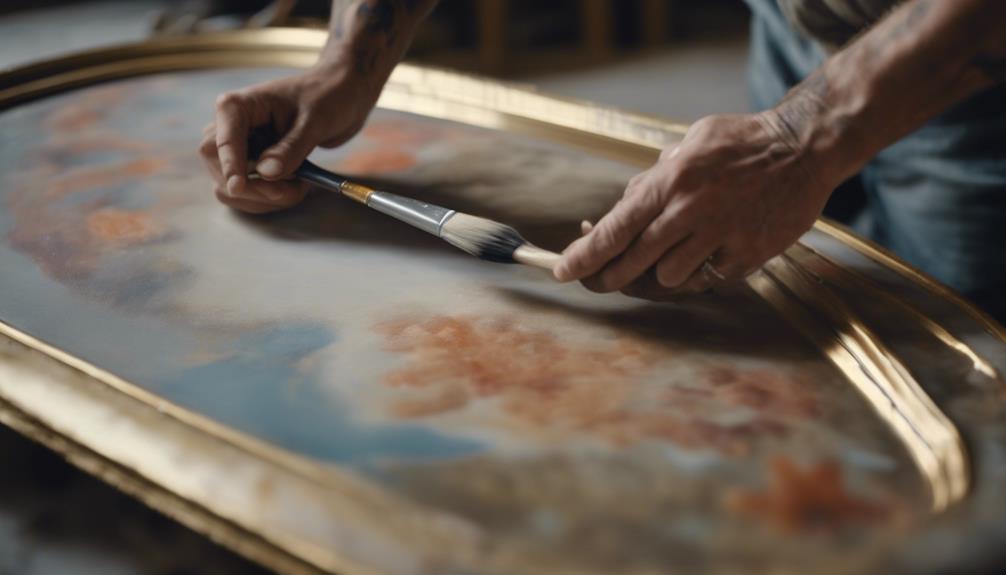
Curing and sealing the fresco is an essential final step in guaranteeing its longevity and preservation. The curing process involves allowing the fresco to dry naturally over several weeks. This period is vital for achieving full strength and durability as the pigments chemically bond with the plaster. Properly curing the fresco guarantees a lasting and vibrant artwork.
Sealing the fresco with a protective coating, such as a transparent glaze or wax, further enhances its longevity. This protective layer helps shield the fresco from environmental factors like dust, dirt, and moisture, preserving its colors and details for years to come. By properly curing and sealing the fresco, you aren't only maintaining its integrity but also ensuring its beauty withstands the test of time.
This meticulous process is fundamental for the long-term preservation of fresco paintings, making them a valuable and enduring art form.
Tips for Successful Alfresco Painting
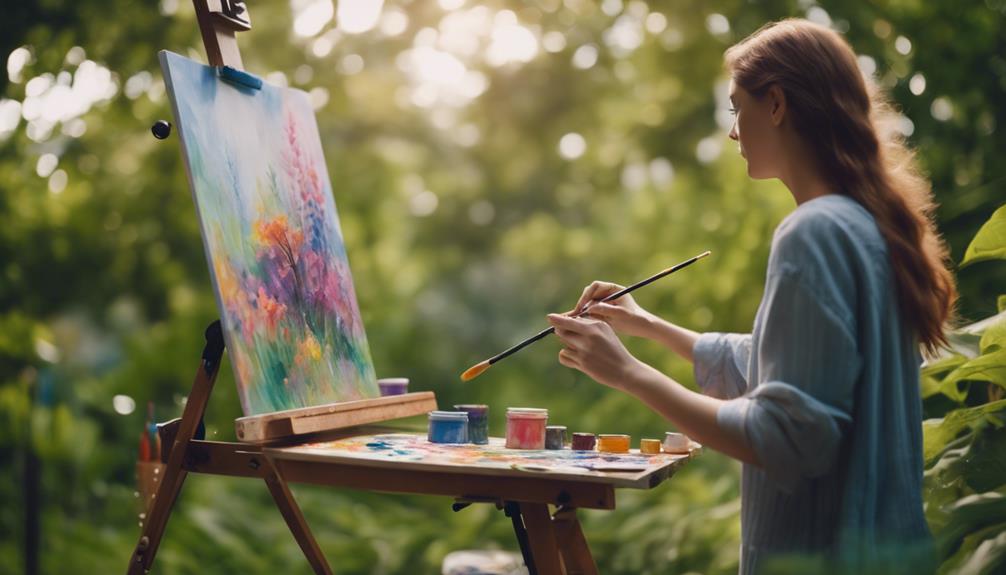
When starting alfresco painting, keep in mind that the choice of location can greatly impact your artwork's outcome.
Considering the weather conditions is essential for a successful painting session outdoors.
Location Choice Matters
Selecting the right location is key to ensuring successful alfresco painting, as it greatly impacts the outcome of your artwork. When choosing a spot for your outdoor painting session, consider factors such as lighting, scenery, and ambiance. Here are some tips to help you make an informed decision:
| Consideration | Description | Example |
|---|---|---|
| Lighting | Opt for locations with natural light sources to enhance colors and shadows. | Painting near a lake during sunset. |
| Scenery | Choose settings that inspire your creativity and complement your artistic vision. | A lush garden with vibrant flowers. |
| Ambiance | Look for places that provide a peaceful and inspiring atmosphere to focus on your art. | A quiet meadow with the sound of birds chirping. |
Weather Considerations Crucial
Considering weather conditions is crucial for successful alfresco painting. It directly impacts the quality and process of your artwork.
Temperature plays a significant role in determining the drying times of your paints. Extreme heat can cause them to dry too quickly, affecting the blending and overall finish of your piece. On the other hand, cold temperatures can prolong drying times, leading to potential smudging or smearing if not carefully monitored.
Additionally, humidity levels in the air can influence how your paints adhere to the canvas, impacting the richness and depth of colors achieved. It's advisable to work during times when the temperature is moderate, avoiding peak sunlight hours that can accelerate drying excessively.
Inspirational Examples of Alfresco Art
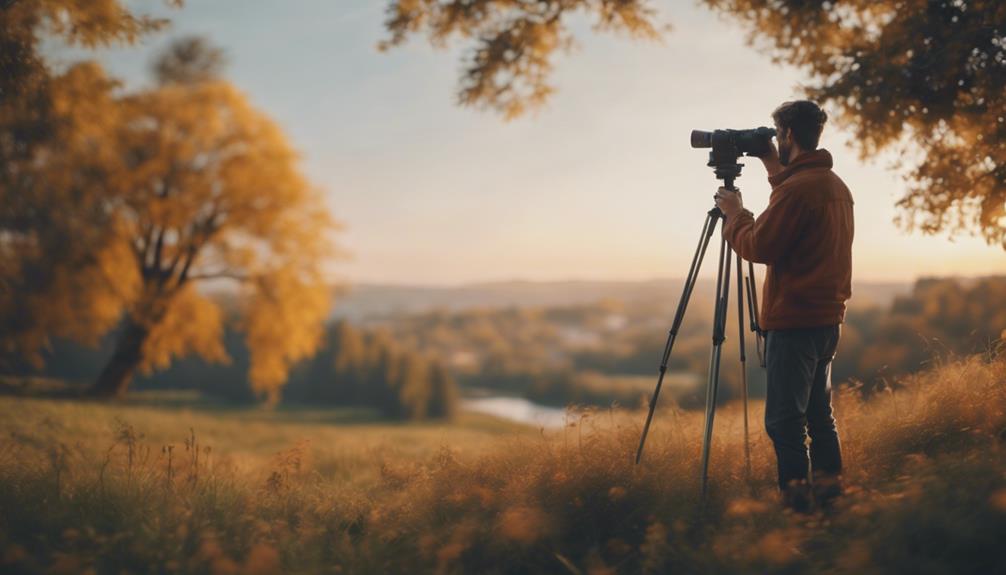
Explore a variety of awe-inspiring alfresco artworks that showcase the beauty and creativity of painting outdoors. Alfresco painting, with its roots in capturing the essence of nature, has produced some remarkable pieces throughout history.
One of the most iconic examples of alfresco art is Michelangelo's masterpiece in the Sistine Chapel. The intricate frescoes adorning the chapel's ceiling are a testament to the skill and dedication required for this painting technique.
Artists like Monet and Sargent also found inspiration in painting outdoors, using plein air techniques to convey the changing light and atmosphere in their works.
These influential artists paved the way for contemporary alfresco painters, who continue to create stunning pieces that blur the lines between art and nature. From vibrant landscapes to intimate portraits, alfresco art offers a unique perspective that can only be achieved by working directly from the natural world.
Preservation and Maintenance of Alfresco Paintings
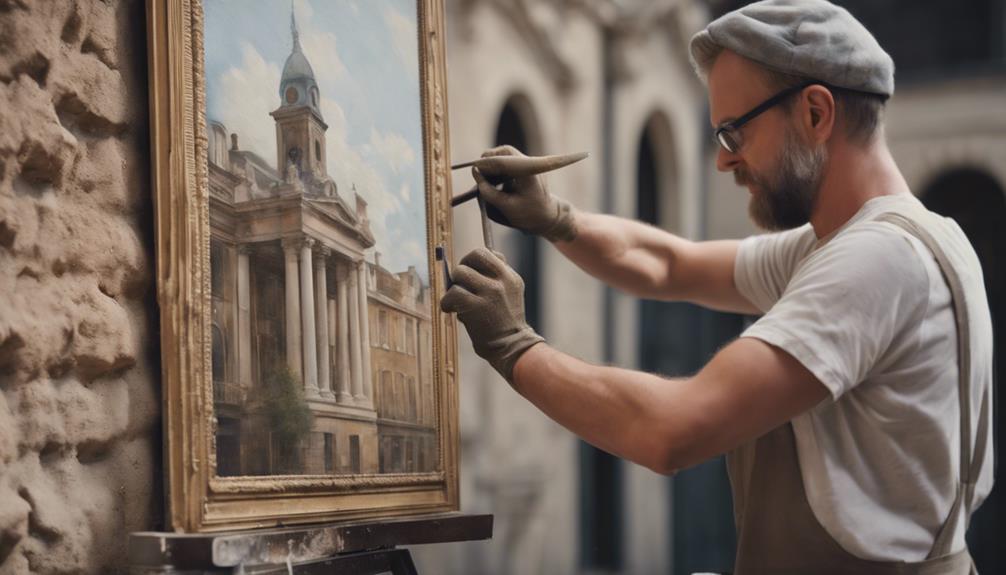
To guarantee the longevity and beauty of alfresco paintings, preservation and maintenance are crucial steps in protecting these artworks from environmental damage. Preservation of fresco paintings involves safeguarding them from weather elements such as rain, sun exposure, and temperature fluctuations.
It's essential to maintain these pieces by regularly cleaning them to remove dirt, grime, and pollutants that could harm the artwork over time. Applying protective coatings or sealants can help extend the lifespan of alfresco paintings and prevent color fading.
In cases where restoration is necessary, conservators may repair cracks, reattach loose paint, and address any structural issues to ensure the durability of the artwork. Professional conservators utilize specialized methods and materials to safeguard fresco paintings, ensuring that their beauty and historical significance are preserved for future generations to appreciate.
Frequently Asked Questions
What Is the Fresco Painting Technique?
The fresco painting technique involves applying water-based pigments on freshly applied plaster, creating durable murals. Artists grind dry-powder pigments in water to create colors that dry and set with the plaster, allowing for detailed artworks.
What Does Al Fresco Mean in Painting?
Imagine painting under the open sky, capturing nature's essence with each brushstroke. 'Al fresco' in painting means embracing the outdoors. Artists use this term to signify creating art in the fresh air, connecting with nature's beauty.
How Does an Artist Create a True Fresco Painting?
To create a true fresco painting, you meticulously apply water-based pigments on fresh plaster while transferring your design. Each day, you paint sections on wet plaster, ensuring colors become permanent as they dry within the surface.
Why Is Fresco Painting Significant?
Fresco painting is significant due to its durability and ability to create monumental murals. Artists like Michelangelo favored it during the Italian Renaissance. Applying water-based pigments on wet plaster makes colors permanent, allowing detailed work.
Conclusion
To sum up, alfresco painting is a timeless art form that requires skill, patience, and attention to detail.
As you commence on your own alfresco painting journey, remember that like a fresco, life is a canvas waiting to be painted with vibrant colors and intricate designs.
So, take inspiration from the masters of the past, embrace the process of creating something beautiful, and let your creativity shine through in every brushstroke.
Happy painting!
Home Decor
Set the Perfect Mood in Any Room With These Lighting Tips – You’Ll Be Amazed!
Unlock the secrets to transforming your space with simple lighting tips that will leave you amazed at the results!
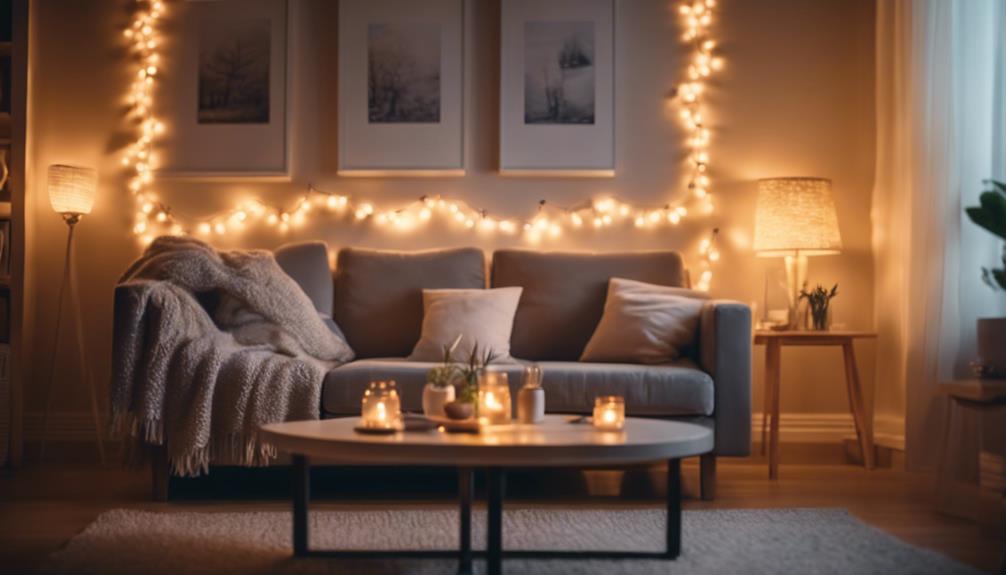
You can easily set the perfect mood in any room with just a few lighting tips. Start by using a mix of ambient and task lighting to create comfort and functionality. Dimming your lights softens the atmosphere for intimate gatherings, while warm-toned bulbs foster positivity. Layer your lighting with floor lamps, sconces, and colored LED bulbs to add depth and visual interest. Consider natural elements, like salt lamps, to enhance relaxation. These simple adjustments can transform your space. For even more ways to elevate your home's vibe, you'll want to explore additional creative lighting techniques!
Key Takeaways
- Use dimmable fixtures or candles to easily adjust ambiance for gatherings or relaxation, creating a warm and inviting atmosphere.
- Layer lighting with multiple sources, such as floor lamps and wall sconces, to enhance room aesthetics and depth.
- Choose warm-toned bulbs to create a flattering environment that boosts confidence and enhances emotional connections.
- Incorporate task lighting in functional areas to ensure safety and productivity while maintaining a cozy atmosphere.
Understanding Mood Lighting
Understanding mood lighting is essential because it can dramatically shape your emotions and experiences in any space. The right mood lighting creates an inviting atmosphere that enhances your feelings and interactions.
Ambient lighting, particularly when it has a warm glow, is vital for setting the tone. It not only softens harsh realities but also boosts confidence, especially in romantic settings.
Research shows that many people prefer dimmed lighting during intimate moments, often due to worries about body visibility and self-image. By using warm tones, you can create a more flattering environment that reduces self-consciousness and heightens enjoyment. This positive lighting can make a significant difference in how you and your partner connect, fostering deeper emotional ties.
Incorporating multiple light sources and adjusting colors can further enhance your space. You're not just illuminating a room; you're curating an experience that promotes well-being and satisfaction.
Types of Lighting to Consider
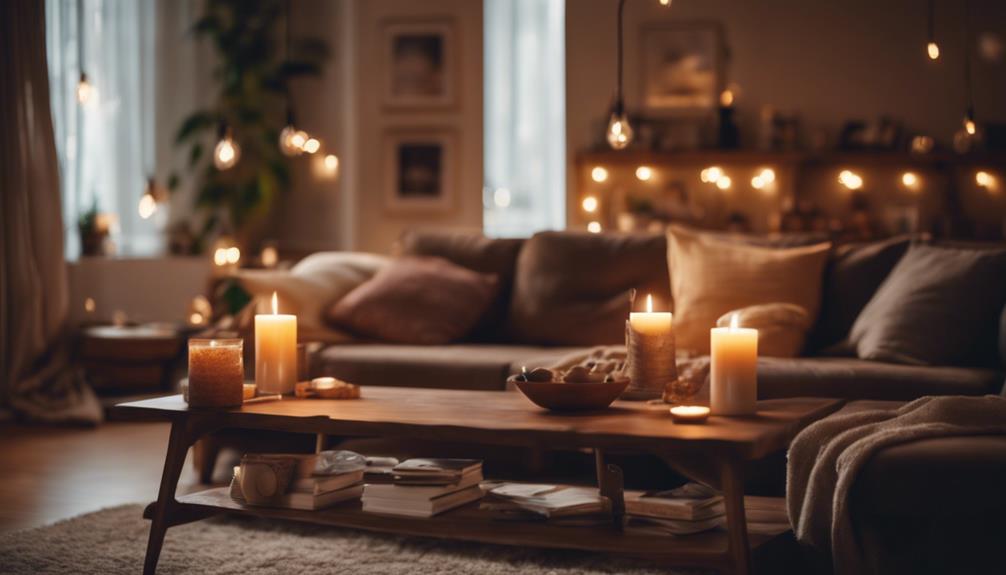
To create the perfect atmosphere in your space, it's important to explore the different types of lighting available, each serving a unique purpose in enhancing your home's ambiance.
Start with ambient lighting, which sets the overall tone and mood of a room. Options like floor lamps and recessed lights provide a soft glow that enhances comfort and relaxation, making your space feel inviting.
Next, consider task lighting. This type is essential for functional areas where you need focused illumination. Under-cabinet lights in kitchens or desk lamps in home offices guarantee you can perform specific activities efficiently and safely. Task lighting not only aids productivity but also prevents eye strain.
Techniques for Effective Atmosphere
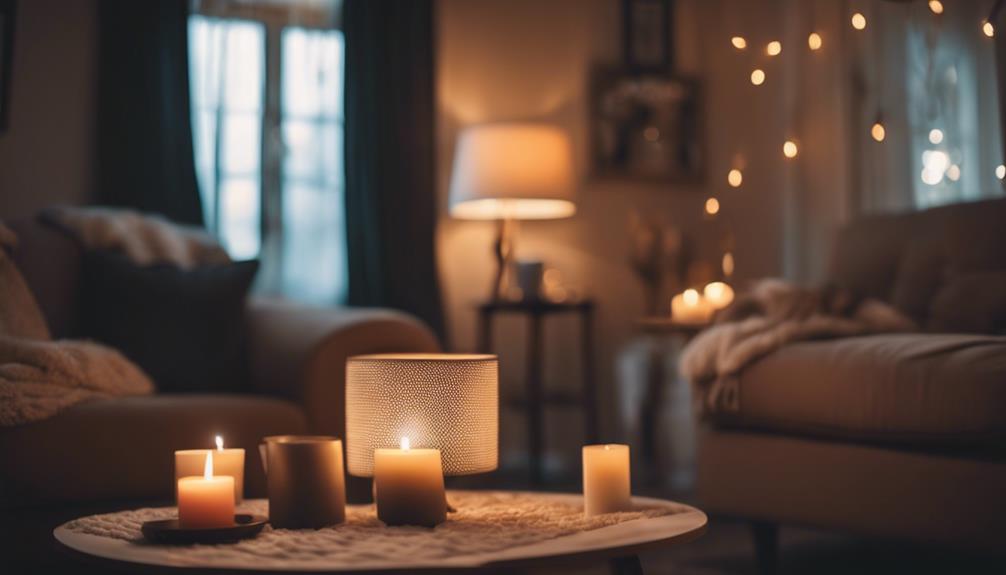
Creating the right atmosphere in your space involves a strategic blend of lighting techniques that cater to your specific needs and preferences.
Start by using dimmable light fixtures or candles to soften the ambiance, perfect for gatherings or relaxation. Multiple light sources, like floor lamps, wall sconces, and table lamps, allow you to adjust the mood effortlessly while enhancing the overall aesthetic of your room.
Consider incorporating smart home technology, which lets you customize brightness and color to suit different occasions. This adaptability guarantees your space feels just right, whether you're hosting friends or enjoying a quiet evening alone.
Opt for warm-toned lighting to boost self-confidence and create an inviting environment, fostering positive interactions. For a calming atmosphere, try adding natural elements like Himalayan salt lamps; they not only provide a gentle glow but also contribute to a soothing vibe.
Creating Intimacy With Light
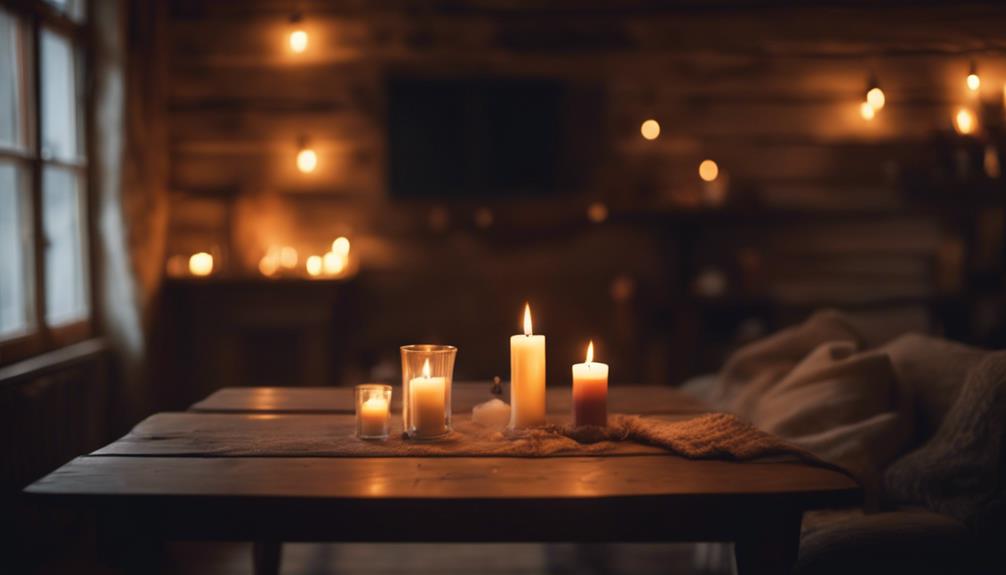
Soft lighting sets the mood for intimacy, helping you and your partner feel more relaxed and connected. When you dim the lights, the atmosphere transforms, inviting a sense of closeness. A warm, amber glow creates a cozy environment that encourages emotional bonding.
According to a Harris Poll, 62% of people prefer intimate moments with the lights off, emphasizing the power of reduced visibility in fostering comfort.
Incorporating ambient lighting solutions like Himalayan salt lamps or colored bulbs can greatly enhance the mood of a space. These options not only cast a soft light but also add a unique charm that can elevate your romantic experiences.
Warm tones in lighting improve appearance and boost self-confidence, allowing both you and your partner to feel at ease during those special moments.
Practical Lighting Tips for Rooms
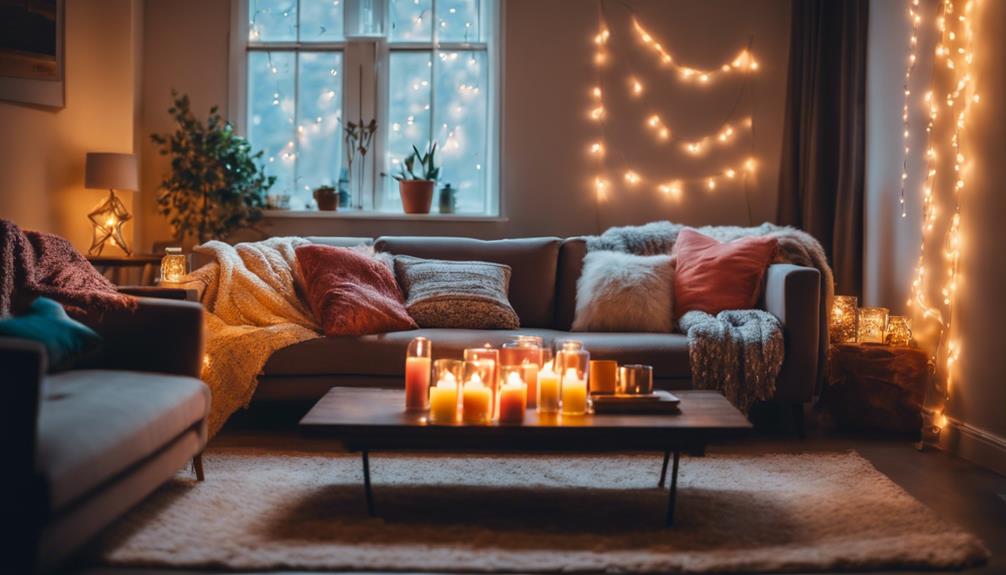
Maximizing the effectiveness of your lighting can transform any room into a more inviting and functional space. Start by incorporating dimmer switches to easily adjust the lighting intensity, allowing you to create the right ambience for relaxation or social gatherings.
Layer your lighting with multiple sources, like floor lamps, table lamps, and recessed fixtures, to add depth and visual interest.
In spaces like living rooms and bedrooms, opt for warm-toned bulbs. They enhance appearance and boost confidence, making your environment feel more welcoming.
For functional areas like kitchens, utilize task lighting by combining overhead fixtures with under-cabinet lights. This guarantees ideal usability and safety while you cook.
Don't forget to experiment with strip lighting! It's perfect for accentuating architectural features or creating a cozy atmosphere in various spaces.
Consider using color-changing LED bulbs as well; they allow you to customize the atmosphere according to your mood or occasion. By mixing different shades and intensities throughout your rooms, you'll achieve a well-lit space that feels just right for any activity.
Frequently Asked Questions
How to Set the Mood With Lighting?
To set the mood with lighting, use warm-toned bulbs and multiple light sources. Incorporate soft lighting for comfort, and experiment with unique options like Himalayan salt lamps to create a playful, intimate atmosphere.
What LED Light Puts You in a Good Mood?
Imagine warm, soft oranges and yellows wrapping around you like a cozy blanket. Those LED lights lift your spirits, while playful purples spark joy, and calm blues keep you alert. Choose your mood, light it up!
How Does Room Lighting Affect Mood?
Room lighting affects your mood considerably. Warm tones can boost your confidence and create a relaxing atmosphere, while bright lights keep you alert. Adjusting lighting alters your feelings, enhancing intimacy and emotional satisfaction during interactions.
How Does Lighting Affect the Mood of a Scene?
You might think lighting doesn't matter much, but it profoundly shapes a scene's mood. Soft, warm tones create intimacy, while harsher lights can evoke tension. Carefully chosen lighting enhances emotions, fostering connections and making moments memorable.
Conclusion
Now that you've got the tools to set the perfect mood, imagine this: you're hosting a cozy dinner party.
Soft, warm lights flicker from strategically placed lamps, while candles on the table cast a gentle glow.
Friends laugh and share stories, feeling instantly relaxed in the inviting atmosphere you've created.
With these lighting tips, you can transform any space, making every gathering memorable and every moment special.
So go ahead, let your creativity shine!
-

 Vetted2 months ago
Vetted2 months ago14 Best Personalized Father's Day Gifts for Your Husband – Show Him You Care
-

 Alfresco1 month ago
Alfresco1 month agoAlfresco Stacker Doors: Seamless Indoor-Outdoor Living!
-

 Craft and Textiles3 months ago
Craft and Textiles3 months ago15 Best Places to Buy Appliances for Your Home – Top Retailers Reviewed
-

 Decorative Throws3 months ago
Decorative Throws3 months agoIs It Better to Dry Clean Blankets?
-

 Tableware and Dining Accessories3 months ago
Tableware and Dining Accessories3 months agoWhat Is the Meaning of the Word Tableware
-

 Tableware and Dining Accessories3 months ago
Tableware and Dining Accessories3 months agoWhat Is the Hindi Meaning of Tableware
-

 Craft and Textiles3 months ago
Craft and Textiles3 months ago15 Best Cordless Mowers for Effortless Lawn Care – Top Picks of 2024
-

 Yarn3 months ago
Yarn3 months agoIs Yarn Natural or Manmade? Unravel the Truth
























